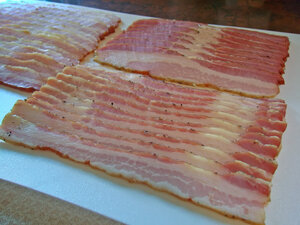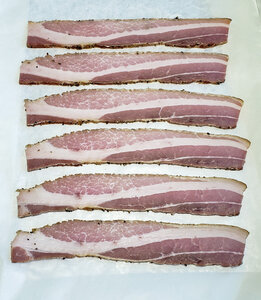Just ask here. Don’t use internet recipes. Any of us will be more than happy to help you develop a good working recipe. Just ask, this place is full of knowledgable people more than willing to help.I'll do that. I was going to test fry after a soak, but I wouldn't have thought to discard the outer piece - thanks.
Here is a link to the original recipe that I used (you'll need to skip down a ways to the section "Dry cure method"). But here is the gist: " Start by combining ½ cup of salt ½ cup of brown sugar, 1 TBS of black pepper, and 1 tsp of Insta-Cure #1. "
I first tried this recipe a couple of years ago, but last year I changed it by eliminating the honey and instead added garlic and onion powder, but kept the salt and sugar ratios the same.
This year I again kept the salt and sugar ratios the same but added some cayenne pepper.
Per 5lbs belly:
-1 tsp cure #1
- 1/2 cup dark brown sugar
- 1/2 cup (144 g) kosher salt
- 1 tbsp cracked black pepper
- 1 tsp onion powder
- 1 tsp garlic powder
- 1 tsp cayenne pepper
Our methods and recipes are time tested and accurate.







